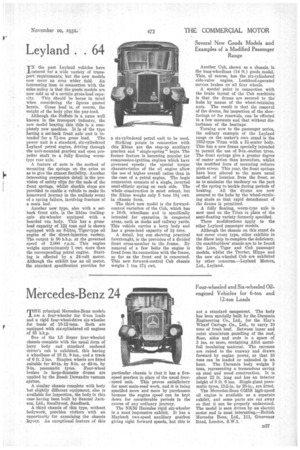Leyland . 64
Page 27

If you've noticed an error in this article please click here to report it so we can fix it.
IN the past Leyland vehicles have catered for a wide variety of transport requirements, but the new models now cover an even wider field. An interesting item in connection with the gales policy is that the goods models are now sold as of a certain gross-load capacity. This should be borne in 'mind when considering the figures quoted herein. Gross load is, of course, the weight of the body plus the pay-load.
Although the Buffalo is a name well known in the transport industry, the new model bearing this title is a completely new machine. It is of the type having a set-back front axle and is in
tended for a 71-ton gross load. The power unit is a standard, six-cylindered Leyland petrol engine, driving through the unit-mounted gearbox and open propeller shaft to a fully floating wormtype rear axle.
A feature of note is the method of mounting the springs on the axles so as to give the utmost flexibility. Another interesting suspension detail is the provision of safety clips for the ends of the front springs, whilst shackle stops are provided to enable a vehicle to make its homeward journey in the unlikely event of a spring failure, involving fracture of a main leaf.
Another new type, also with a setback front axle, is the Rhino trailingaxle six-wheeler equipped with a boarded van body. This has a grossload capacity of 121 tons and is shown equipped with an 8-litre, Tiger-type oil engine of the direct-injection variety. The output is 90 b.h.p. at the governed speed of 2,000 r.p.m. This engine weighs approximately 1 cwt. more than the corresponding petrol engine. Starting is effected by a 24-volt motor. Although the exhibit has an oil motor, the standard specification provides for
a six-cylindered petrol unit to be used.
Striking points in connection with this Rhino are the step-up auxiliary gearbox and " single-spring " bogie. The former feature is becoming popular for compression-ignition engines which have governed speeds; the special torque characteristics of the oil engine allow
• the use of higher overall ratios than in the case of a petrol engine. The bogie suspension consists of a single, inverted semi-elliptic spring on each side. The whole ,construction is most robust, but the Rhino weighs only 5 tons 181 cwt, in chassis form.
The third new model is the forwardcontrol variation of the Cub, which has a 10-ft. wheelbase and is specifically intended for operation in congested areas, such as docks and railway yards. This vehicle carries a lorry body and has a gross-load capacity .of 21 Ions.
A detail, but one showing practical forethought, is the provision of a divided front cross-member to the frame. By removal of a few bolts the engine is freed from its-connection with the frame, so far as the front end is concerned. This new forward-control Cub chassis weighs 1 ton 171 cwt.
Another Cub, shown as a chassis, is the long-wheelbase (14 ft.) goods model. This, of course, has the six-cylindered side-valve engine, Lockheed-operated service brakes on all four wheels.
A special point in connection with the brake layout of the Cub machines is that the drums are secured to the hubs by means of the wheel-retaining nuts. The result is that the removal of the drums, for inspection of the shoefacings or for renewals, can be effected in a few moments and that without disturbance of the bearings.
Turning now to the passenger series, the solitary example of the Leyland range on the maker's own stand is the 1932-type Titan with a 51-seater body. This has a new frame specially intended to permit the use of 9-in--section tyres. The front springs give a greater degree of castor action than heretofore, whilst the modified form of mounting reduces plate stress. This year, the front springs have been altered to the more usual method of location from the front, so as to minimize the tendency on the part of the spring to buckle during periods of braking. All the drums are now secured to the hubs by the wheel-retaining studs so that rapid detachment of the drums is permitted.
A fully floating, 'worm-type axle is now used on the Titan in place of the semi-floating variety formerly specified.
These modifications apply to the other Leyland passenger models.
Although the chassis on this stand do not cover every type, other exhibits in the Show help to complete the deficiency. On coachbufiders' stands sire to be found the Lion, Tiger and Cub passenger models, whilst the Terrier, Hippo and the new six-wheeled Cub are exhibited by other concerns.—Leyland Motors, Ltd., Leyland.
















































































































































